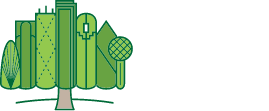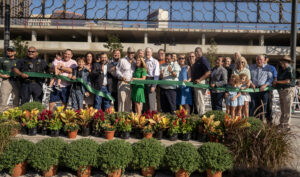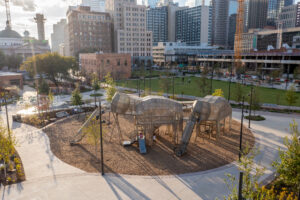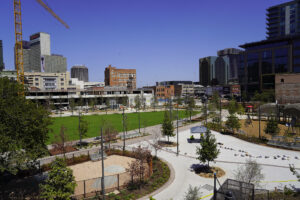When a new park is introduced to the city, it may seem like the final step in a straightforward process. But the truth is constructing a park in urban landscapes is a complex journey that requires the working together of many different parts.
To get a better understanding, check out this step-by-step breakdown that explains how Downtown Dallas Parks Conservancy and our Campaign for Downtown Parks is partnering with the City of Dallas to transform underutilized land into new public green spaces.
Land Acquisition Phase
Before a park can even enter public consciousness, land has to be available and acquired. This happens through either public or private dollars or a combination of the two, and the process can take years.
For example, the 3.8-acre site that will one day be Harwood Park has been in the works since 2013, when it was first identified in Dallas’ Downtown Parks Master Plan Update. In conjunction with donors and private sector partners, Downtown Dallas Parks Conservancy worked for three years (2014-2017) to assemble the land so that it will one day be a public park.
The land for Pacific Plaza, which opened in October 2019, was in the works for close to a decade and was acquired over multiple years by Trust for Public Land. While it was conveyed to the city in 2008, it remained a parking lot until DDPC pledged $15 million in 2016 to fund the design and construction of the park.
Schematic Design Phase
Once land is identified, design can begin. This starts with what’s called “schematic design”; in other words, high-level, conceptual design headed by the landscape architect.
Public input meetings will then be held to receive feedback from the community. This ideally includes two meetings, one during the day (for people who work in the area) and one during the evening (for people who live in area) and are held at a venue in close proximity to the park site. Meetings follow a townhall format, with a presentation and Q&A, and represent an invaluable part of the process, as they illuminate the specific needs of that neighborhood. After the design presentation, participants are invited to take a closer look at the design images, ask questions, and respond to the prompts on the design boards or comment card.
Once the schematic design is complete, the city’s Parks and Recreation Department will comment on the scheme, and provide approval to move on to the next phase of design.
Design Development Phase
Design development is where the bulk of the designing process happens. After receiving initial feedback on schematic design, the landscape architect will present more advanced concepts to the Parks and Recreation Department. Through this iterative process between city departments and the architect, the material palette will be selected and the park features will be finalized.
In addition, if the park is located in a historic district design plans will go to the Landmark Commission for feedback and certification that the park is aligned with the design standards required in that particular historic district. In certain instances, such as with West End Square, the Texas Historical Commission may require an archaeological review before the park can break ground to ensure it’s not built over a significant historical site.
In addition, more “technical” conversations are happening at this point, as the city evaluates what the maintenance and operation budget will be for the park. For example, the cost of maintaining a water feature will need to be worked into the operations budget for the park system.
Environmental studies are also conducted at this point, and the city may choose to request further testing to ensure all environmental concerns are addressed. This type of “site development” work is usually ongoing during design and into project construction.
Construction Document Phase
During the construction document phase, park project team will collaborate closely with the city’s Sustainable Development and Construction department to make sure the park is in compliance with all zoning and construction requirements. This can take a significant amount of time, as each site is unique and plans for construction are often submitted and resubmitted many times over.
Construction will not begin until the city has approved the final design and given official notice to proceed.
Construction Phase
How the park moves forward into construction is determined by how it’s funded. For Pacific Plaza, which was privately funded, Downtown Dallas Parks Conservancy was able to select a general contractor to work on the project team from the start of design to construction to help optimize schedule, pricing, and design decisions that ultimately save time and money that can go back to the park . In contrast, Carpenter Park, which will utilize public bond dollars, must go through a city procurement process, which includes open bidding, contract negotiations and City Council approval. This process takes several months.
Once construction begins, the schedule is largely dictated by the general contractor. Many moving parts are taken into account, from utility relocation and street closures to prime planting season for vegetation. Inclement weather will also affect the park’s timeline.
During construction, structural and playground safety reviews are also scheduled, as well as compliance with the Americans with Disabilities Act (ADA) Standards for Accessible Design.
To learn more about the construction phase of Pacific Plaza, see this interview with Jim Shipley, Project Manager with the Beck Group.
Post-Construction Phase
Once construction is complete, the park can officially open to the public. This usually includes a ceremony and free activities to introduce the space and its amenities to the community.
At this point, contractors will still go back and do final checkups to ensure the park is functioning at its full capability, sometimes choosing to reinstall or replace warrantied items as needed. Finally, the park will be formally submitted to the Parks and Recreation department to be dedicated as parkland.
Even then, the work is never finished. Downtown Dallas Parks Conservancy will continue to keep close tabs on the park and be ongoing advocates for its long-term health. DDPC is raising $25 million for the Downtown Dallas Parks Conservancy General Endowment to support maintenance costs and future capital improvements for all Downtown parks.
Which phase of building a new public park do you find most interesting or surprising? Let us know your thoughts on Facebook, Instagram and Twitter.





